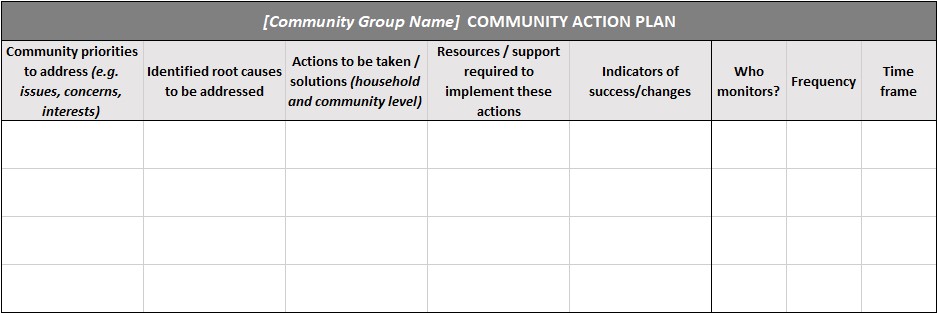This resource provides a community action plan template for community groups to document their priorities and identified solutions/actions to achieve the animal welfare improvements and associated actions to change their behaviours based through their collective reflections using participatory learning and action activities. Some of the participatory tools that are relevant prior to using this template are T34 Community Animal Welfare Action Planning, T33 Community Animal Welfare Needs Assessment, T22. Animal Welfare Transect Walk, T8 Pairwise Ranking and Scoring, T9 Matrix Ranking and Scoring.
Keyword Search Tags
Project Phase:
Planning Phase, Implementation Phase, Exit and Evaluation Phase
Approaches for Working With Communities: Community Development Approach
Stages of Behaviour Change:
Preparation Stage, Action Stage, Maintenance Stage
Project Support: Facilitator Resources, Documentation and Reporting
Specific Topics: Group Formation/Strengthening
The community will go through a process of identifying the different animal welfare issues, prioritizing them, and using the template provided below to document the results of their reflections and decisions.

Facilitation Notes:
The table can be filled after
· After communities identify and ranked them in order of importance, pick the prioritized animal welfare issue. Document the identified major root causes and let them discuss and identify the actions/behaviours or solutions. Such actions need to be owned by the community members to tackle them at community/group level or at each group member’s household level. Ensure appropriate participatory process of exploration, learning and reflection takes place before coming into agreement and developing/populating the community action plan. The developed action plan needs to be monitored, and members should be encouraged to be accountable and also express challenges they encountered.
It is important to note that some of the proposed actions may have been tried out previously by the equine owners with minimal or no success, hence the facilitator should probe further to ensure participants reflect through any previous actions and what was the gap and settle on the actions with greater chances of realising the changes anticipated.
· This document will serve as a living document to plan action as well as to continue to re-prioritize actions to be taken by the group on their own or in conjunction with other external stakeholders that will support them to execute the actions they have identified. It is thus important for facilitator’s to frequently remind community members to review developed action plans and report back or adapt them based on emerging needs and changes.
· *one prioritized issue can have more than one action; so add rows to identify and each action can be monitored by different stakeholders and have different success indicators
· * Actions – could include a specific behaviour/actions they agreed to take individually and/or collectively.
· *frequency could include community members checking/supporting each other as part of peer support to provide practical or/and emotional support to one another
· Timeline – when the identified action is done and when it needs to be reported
· *who is responsible is taking the action and they need to report back when the group meets again/in the group meetings; this could also be used as a behaviour change technique of monitoring each other’s practice of a desired behaviour
Resource adapted from [136]